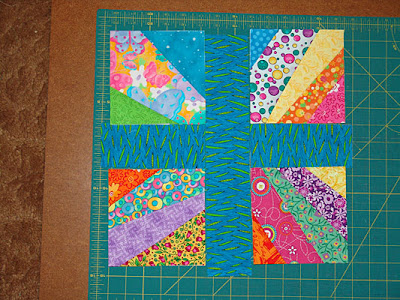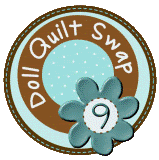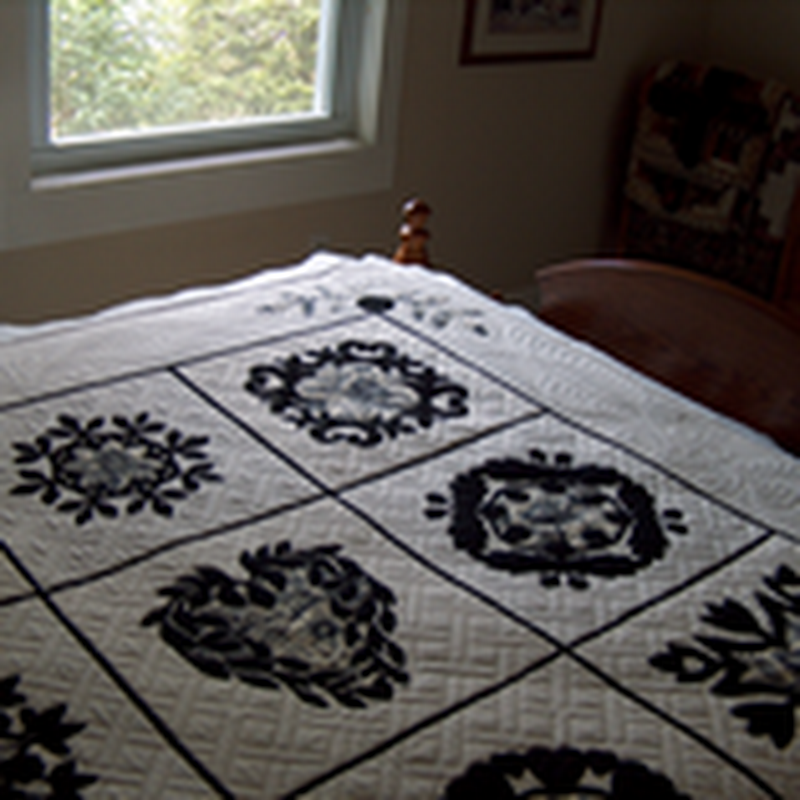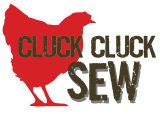While looking at vintage quilts, blocks and patterns on Ebay recently, I came across a particularly interesting vintage quilt. Despite the fabrics being obviously older, the pattern actually reflected similar designs now called modern. Now this quilt (which seems to contain every fabric she ever came across in this one quilt) was made lovingly by someone somewhere long ago, but she would have related well to all the wonky and liberated quilters out there. So in honor of that early quilt maker, I'm naming this block inspired by her quilt, Vintage Liberation. I had a lot of fun making this block. It's quick, easy, requires very little measurement and even less pinning. This is a great 12.5 inch block to use up all those little scraps that were too short for a string quilt and too narrow for squares. Here she is:
I'll be making my quilt blocks in Spring and Summer tones, so no blacks, navys, autumn hues, icy blues, etc. We're talking warm, cheerful, happy colors!
Warning: I actually worked on two blocks at the same time, so you will see some photos from each. Don't get confused by this, they're the same steps, just different fabrics.
For supplies you will need: rotary cutter, quilting ruler (I used my 6.5x24 in, 4x14in, and 15 in square ones, but you really don't need that many, just something to measure at least 5.5 inches and something to measure around 14 inches), pencil, tweezers, 4 pieces of regular printer paper (or thinner if you have it), one piece of print fabric measuring at least 6 in x 13 in, assorted scraps some of which should be at least 9 inches long. Your scraps can be a mix of prints and solids, just use what's in your scrapbag. Of course you'll want your sewing machine (so much faster than hand sewing), 75/11 or 80/12 universal or sharp needle, neutral colored cotton thread (I used a light gray) and a cutting mat.
Let's get started!
First, you'll need to cut four (4) 5.5 inch squares from the printer paper. Be accurate. The neater job you do here, the better results you'll see at the end. Once cut, you can draw lines at varying angles across (these will be stitching lines like in foundation piecing) or you can leave it blank and just work as you go. I did a little of both. Lines might be easier if you aren't very familiar with wonky or liberated style blocks. (Hey, don't mock security blankets, they keep you from getting frustrated until you are ready to let go!) Remember when drawing your lines that you will want 3-6 sections for best results and you don't really want them all even--we're being liberated!
You'll also want to draw in your 1/4 inch seam allowances. You can always wait and do this part later, but it is easier when the paper is flat and doesn't have fabric sewn to it!
Now you can begin attaching your scraps. Start anywhere on the square--corner, middle, off-center--it all works! I base my starting point on my fabric piece size. Smaller piece? Start at a corner. Wherever you start, the fabric must cover from one edge of the block to the opposite at whatever angle you've chosen. Be a little generous with yourself on estimating needed sizes and you'll find yourself a lot less frustrated with pieces that don't quite fit after being sewn, believe me, I know! (Tip: Shorten your stitch length, it will make removing the paper later much easier.) Each piece you sew down should have at least one straight edge to follow when stitching, after all, you want liberated/wonky not curvy. As you add each piece, be sure and trim, press to set the seam, then fold open and press again. I prefer a dry iron when working with paper foundations. I only pin the first piece down to hold it in place. The next piece is place right side down on top of the first. You will stitch either along your pre-drawn lines (double check that you definitely left yourself a seam allowance) or use the straight edge of the second piece as a guide. Use 1/4 inch seams. Lay pieces down at varying angles as you work across the block.
If you're working without pre-drawn lines, you'll work from the fabric side. Again, use the straight edge of each piece as your sewing guide. Don't try to just wing it and sew across your fabric without a straight edge to guide you, it is way too easy to start getting a wobbly line and you will be disappointed in your results. Here you can see that the bottom fabric piece sticks out and doesn't line up with the current top piece. That's normal! I'll show you how to get rid of the excess as you go in just a moment.
If you are sewing following drawn lines, you will sew from the paper side of the square. I like to hold the paper up to the light so I can see the fabric through it and adjust my angle and seam allowance before stitching down.
Now, each time you stitch some fabric down, you'll have some excess beyond the normal 1/4 inch seam allowance. This is normal because you are sewing in a wonky style. But, you won't want to keep that excess, so you will want to trim as you go. Keep your rotary cutter and a small ruler hand for quick accurate cutting.
First, flip the block to paper side up and fold back the paper that is under the excess part--you don't want to cut your paper! The sewn seam will provide a nice fold line.
Now flip back to fabric side up and line your ruler up along the stitched seam so that you have a 1/4 inch seam allowance allowed and trim off the extra fabric.
Now fold the paper back to its original location. Continue pressing and adding fabric until you've covered the entire 5.5 inch square.
Once your square is finished, use your straight edge ruler and rotary cutter to carefully trim off any fabric sticking out beyond the paper. Be careful not to trim into the paper!
Move your blocks around until you find an arrangement you like. Here are two blocks worth that I've sewn up. You can see I've arranged one in almost a diamond shape and the other in an X shape. I like both equally well. You don't have to form these patterns, you could have them going any direction really. Find what is most visually appealing with the fabrics and lines that you have. This also lets you see the variety to the wonkiness of the fabric scrap strips.
Take your 6x13 piece of print. You will cut two 2.5 inch strips from this. Next, taking one strip, cut two 6 inch pieces. (These strips are a bit longer than what you'll need. This gives you a bit of wiggle room when sewing down the first side which can sometimes "adjust" itself on you.)
I like to lay out my blocks and strips to preview what the final block will look like. It can get a bit crazy with all those prints, so you want something that gives interest, not eye-strain! I went with a pink print for one set which had more Spring-like tones and a blue print for the more Summer-ish set of squares.
At this point, I often take a quick digital snapshot so that I can remember my block layout once I start picking up and sewing pieces. This is especially helpful if you're making more than one block at a time!
You are now ready to sew on the strips. Start with the shorter ones. Place right sides together. Match up the longer edge of the strip to the edge of the square. Let the small extra length of the strip hang off both sides. If needed, use a pin or two to hold the strip in place. You want to line up the edges of the strip, the fabric strips and the paper square.
Now flip the square over and stitch along the lines you drew earlier to form the 1/4 inch seam allowance. The lines, you will find, allow you to focus on keeping the edges lined up without worrying about a consistent seam allowance which is important for best results. You may find that you also sew a bit faster as you only need to follow the line!
Press open so that the seam allowance goes towards the strip. This helps cut down on bulk. Trim the strip so that the edges are now even with the square.
Repeat the process with another square and the other long edge of the short strip. Again press the seam towards the strip. Do this for each short strip. You will end up with two "paired" squares like this.
The long strip is the last sewing part! Line up the long edge on the edge of one set of paired squares. I like to work left to right, it helps me keep things straight, but feel free to work right to left. Let the extra length hang off each end. I recommend using a few pins to hold the strip in place. Flip to the paper side and sew along your lines (just like you did for the short strips). Press seam allowance towards the strip.
Trim the long strip so that it is even with the paired squares. This view of the back shows you all the seams at this point. You can see how quickly the bulk would build up if you didn't press towards the strips! Sew the second pair of squares to the other side of the strip and press towards the strip.
Your block should now look like this from the back. I like to give the whole block a good press prior to removing the paper foundation. I find the paper comes off easiest if I start with removing the paper in the outer edge seam allowances and then work from an outer corner towards the middle. Fold each paper section (not the fabric) back before tearing away and then carefully tear off paper. This is not an exercise in brute strength. Take your time and work gently to avoid distorting your carefully made blocks or pulling stitches. I like to work on paper removal during mindless television moments like commercials or the Oscars. But this block is pretty quick. Use your tweezers to snag little bits that get caught--just be careful not to snag some of the seam's thread too. Remember, really tiny bits will wash out when the quilt is laundered at some point in the future, so don't go blind trying to get microscopic bits of paper out of tight corners!
If you were neat and careful in your cutting, trimming, pressing and seam allowances, you will probably not even need to do further squaring up. Here are my two Vintage Liberation blocks:
I plan on joining my blocks with a 2.5 inch strip sashing with 2.5 inch squares at the meeting points. I haven't decided if I'll use a print or a solid--I'm still having fun with blocks. And best of all, my scrap pile is getting smaller! Go get your scrapbag and make yourself a quilt!
























































Great tutorial. I'm inspired to try this. Great way to use up those scraps.
ReplyDeleteoh my gosh, i love this!! i think you've given me the perfect block for my month of a string bee!
ReplyDelete